There are so many options with technology these days, and everyone tells you something different about what your web site should do and how it should interact with different software and gadgets and other things.
But sometimes the most essential elements get lost in the shuffle. We see lots of people wasting lots of money on things that won’t work, simply because they don’t have these basics covered. Sometimes tiny changes yield HUGE results.
If your site doesn’t include these three elements, everything else becomes MUCH less effective.
Here they are:
Transcript – Three Essential Elements of an Aviation Web Site
 Paula Williams: Welcome to this week’s episode. Today we’re talking about three essential elements of an aviation website.
Paula Williams: Welcome to this week’s episode. Today we’re talking about three essential elements of an aviation website.
John Williams: Great.
Paula Williams: Yeah, these are important.
John Williams: Evidently, or we wouldn’t be talking about them.
Paula Williams: Exactly. And it’s been driving me crazy lately how many people don’t understand this. So, we thought we would do a public service announcement, great?
John Williams: Great.
Paula Williams: Exactly. Okay. And of course …
John Williams: Hopefully a public really feels serviced after we’re done.
This episode brought to you by our Aviation Web Site Refresh
Paula Williams: Hopefully. Right, so this episode is being brought to you by our ABCI Web Site Refresh, and, of course we do websites and this is our business, so we’re probably a little more sensitive than most people about people about people spending money on things that aren’t serving them. It Frankly makes the entire industry look bad.
John Williams: We just won’t do it.
Paula Williams: Right, exactly.
John Williams: In fact, we’ve turned somebody down recently, because they didn’t want to follow through.
Paula Williams: Right? Exactly. It takes more than just a website.
John Williams: Exactly.
Paula Williams: Okay. So, our Aviation Website Refresh service, if you order it before March 31st of 2020, you get three free videos. That will make it a lot more updated, a lot more modern, a lot more interactive, and hit the essential elements of an aviation website. Because we only work with aviation-related companies.
Paula Williams: You can use those three videos for your website, you can use them for social media, whatever your marketing situation requires.
John Williams: And since Google is ..
Paula Williams: Rewarding video nowadays.
John Williams: These days, that would be a good thing.
A web site is no good if no one sees it but your Mom
Paula Williams: Exactly, so we’re kind of doing this to help give you a boost. When you launch a new website, you also want to make sure that Google notices it, so.
John Williams: Exactly.
Paula Williams: Having things that has many different formats that you possibly can will help with that.
John Williams: People don’t realize their website all by itself sticking out there doesn’t do a whole lot with respect to Google, and they’re 70% of the U S traffic.
John Williams: So, there are other things that have to be done in a succeeding 90 to 180 days that we’re willing and able to do, but they don’t come free.
Paula Williams: Right. There’s actually several podcasts that we’ve done on aviation search engine optimization and that’s not what we’re talking about today. What we’re talking about today is the website itself, what people expect to see when they get there and how it works, and how it interacts with everything else. So, what is your website supposed to do in 2020?
John Williams: I don’t know, I guess the same thing it did last year.
Your web site is the biggest piece of marketing real estate that you own and control completely
Paula Williams: I think even more so. Your website is probably the biggest piece of marketing real estate that you own. Even if you do a lot of trade shows, even if you buy a lot of magazine ads, even if you do a lot of social media. All of those things are kind of on other people’s turf, but the real estate that you own yourself and you control yourself is your website.
Paula Williams: You control everything there is about that. There’s no other advertising right next to it. You don’t have to worry about whose in the booth next door to you. You don’t have to worry about the social media changing their rules, any of that.
John Williams: And it’s not a, do it once and set and forget. One of our clients been in the business for a bunch of years and been with us a long time, and they got to the point where they needed a website refresh and they had people calling in and said, are you guys still in business? Your website hasn’t changed.
Your web site is the hub of your marketing efforts
Paula Williams: Right, exactly. But, just about every marketing activity that you do nowadays, all roads lead back to your website. So you go to a trade show and you say, you know, look this up on our website or connect with us on our website.
Paula Williams: You give people a business card when you’re at a trade show and it has your website address on it.
John Williams: True.
Paula Williams: They see a magazine ad for more information, visit us online. You know, if you post on social media, a lot of those posts are going to have links back to your website where they can go for more information.
John Williams: And if you actually use business letterhead, it would be on there too.
Paula Williams: Right? Google. You know, when people look up a keyword on Google, like somebody found me today that was looking for aviation FBO marketing, and yesterday someone found us looking for broker sales training.
Paula Williams: So those are two things that they looked up. They weren’t looking for ABCI, they didn’t know we exist yet unfortunately, but for whatever reasons.
John Williams: There’s a problem, sounds to me like.
Paula Williams: Exactly. But they did know they needed broker sales training and they did know that they needed marketing for their FBO. So those were the things that they were looking for on Google and ended up at our website.
Paula Williams: Whenever you send an email, it usually has a link in there to your website for more information. See our website.
John Williams: Or should.
Paula Williams: Whenever you send a postcard, there’s only so much you can put on a postcard, but then you can lead them to a video or lead them to the next step in your sales process, usually on your website.
John Williams: Mm-hmm (affirmative).
Most other marketing efforts lead to your web site.
Paula Williams: So, that being said, you know the old saying, all roads lead to Rome?
John Williams: At least to your website.
Paula Williams: Right? During the Roman empire, it was Rome. In 2020 it is your website that all roads lead to, right?
John Williams: Mm-hmm (affirmative).
Paula Williams: Okay. So all of that being said, there’s some pretty high expectations on that poor little website. Right?
John Williams: True.
The three essential elements of an aviation web site
Paula Williams: Okay, so three key elements, three things that we expect your website to do, are to be relevant, current, and stable. And we’re going to talk about each of these things.
John Williams: Wow, that seems fairly basic, but most people don’t realize the necessity of those three.
Paula Williams: Just because it’s simple doesn’t mean it’s easy.
John Williams: True.
Relevance to your customers (not your board of directors!)
Paula Williams: Okay. So first of all, let’s talk about relevant. A lot of websites that we see are about the company. They talk about the history of the company, the founder of the company to dah, dah, dah, dah, dah, dah, dah, dah. Nobody cares. Right?
John Williams: Yep.
Paula Williams: These two people that I talked to in the last couple of days, they’d never heard of ABCI. They’d never heard of us.
John Williams: They didn’t care.
Paula Williams: Astounding.
John Williams: Well, true. However.
Paula Williams: They knew what they wanted and they knew what they were looking for, but they didn’t know or care about ABCI they didn’t care about Paula Williams. They didn’t care about John Williams. The nerve, right?
John Williams: Exactly.
Paula Williams: But what they care about is …
John Williams: Marketing their company.
Visually and verbally address your customers’ immediate needs first. You can talk about yourself later!
Paula Williams: Exactly. So, it really should be about your customers and what they want or need. You know, the reason that they’re looking for you. What is the problem that they’re having at the moment? Right?
John Williams: And how can you solve it for them?
Paula Williams: Exactly.
John Williams: Or with them.
Paula Williams: Right. So, most charter companies … I want you to picture in your mind, the website of a charter company … what is the first thing you’re going to see?
John Williams: I have no idea.
Paula Williams: An airplane?
John Williams: Probably.
Paula Williams: Right, and pictures of maybe people who founded this charter company?
John Williams: Probably.
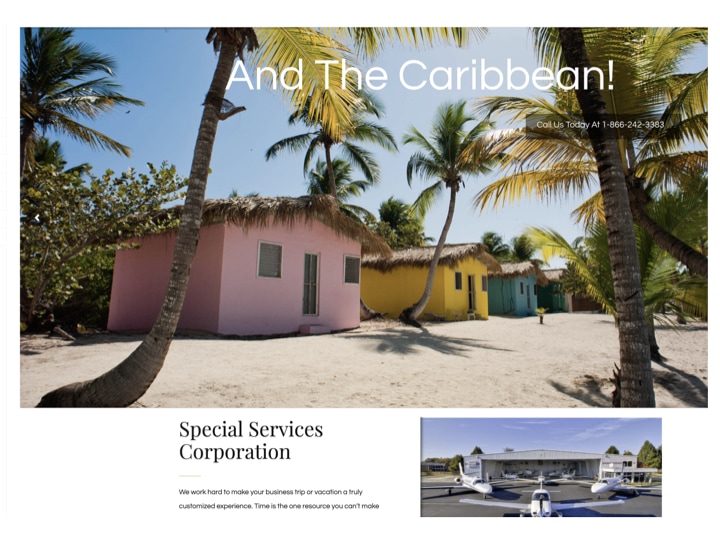 Paula Williams: Okay. SSC has taken a completely different tack because they know that people who are coming to them for charter services … to them charter is a means to an end. Right? And what does that end? They want to be on this beach, right? With their family enjoying some time off, or they want to be at a business location faster and less with less hassle than going through the airline security lines and all that.
Paula Williams: Okay. SSC has taken a completely different tack because they know that people who are coming to them for charter services … to them charter is a means to an end. Right? And what does that end? They want to be on this beach, right? With their family enjoying some time off, or they want to be at a business location faster and less with less hassle than going through the airline security lines and all that.
Paula Williams: So they know that charter is a means to an end, and their website reflects that. So if your business is a means to an end to your customer, and I don’t mean that in an insulting way, right?
John Williams: No, not at all.
Paula Williams: But you know, for us it’s about more sales. You know, the first thing you see on our website is we help aviation companies sell more …
John Williams: Stuff …
Paula Williams: … of their products and services.
John Williams: Yeah, actually that’s right.
Paula Williams: Okay. So it’s about your customers is not about you. So that’s what we mean by relevant. Right?
John Williams: Okay.
Paula Williams: Okay. So if your website is about you, stop right now.
John Williams: And rethink …
Why does your web site need to be up to date?
Paula Williams: And rethink. Okay. Now let’s talk about current. Why is it important for your website to be current?
John Williams: Well, because people that come back and look at your site after a few years, a few months.
Paula Williams: Nothing’s different?
John Williams: Yeah, if nothing’s different in this day and age, it means it’s either stale or maybe you’re not in business anymore.
Paula Williams: Right. Or you know, if you get on somebody’s airplane and it looks like it has not been properly maintained, you’re going to feel of weird. You know, especially, you may only see the Kevin, but you’re going to see … has it been kept up, you know, have, have they been making repairs to the cabin? Have they been fixing the hole in the carpet? Have they been cleaning the armrest? You know, all of those things.
Paula Williams: If not, it makes you wonder how are they running their business? Right. Okay. It’s the same thing with your website. If you’re not keeping it up and you’re not scrubbing those armrests and you’re not updating the information and the look and feel of your website, people may wonder how seriously are you taking your business?
Paula Williams: And one thing that people often look for, even if it’s subconscious, is do you have photos that are clearly outdated? You know, where people are using cell phones the size of bricks? Or where they’re showing your office with the old luggable computers or something like that.
Paula Williams: You know, you want to look through that and make sure that it looks like something is happening at your business.
John Williams: Treat it like a billboard. I mean, you drive down the road and you see billboards that are torn and faded. Windblown.
Paula Williams: Right.
John Williams: And you don’t care about those. You don’t even look at them.
Your web site must be stable, or the other two don’t matter.
Paula Williams: Right? Exactly. Okay, so we talked about relevant, we talked about current. Third thing is …
John Williams: Stability.
Paula Williams: Stable, right? And this is the most important thing. If your website is intermittent that it is not going to be serving you very well. And it also doesn’t reflect well on your company that you don’t run a tight ship and keep your systems in order and other things like that.
Paula Williams: So if your website goes down, all of those other marketing activities that you’ve been doing and that you’ve invested money in, you know, you just paid a ton of money for a magazine ad, but your website is down.
John Williams: And so they go there and can’t find it.
Paula Williams: Then a lot of the people that have seen your magazine ad may not take the next step in your sales process, if your website’s down. So it’s like a broken bridge, you know, between the thing that you bought to them, the thing that you want them to get to.
John Williams: Mm-hmm (affirmative).
What happens when your web site goes down?
Paula Williams: Okay. All right. So typically what happens when your website goes down, if you’re working with a lot of the, shall we say, traditional or less expensive hosting companies? Say your website is, is on the Fritz, right?
John Williams: Yep.
Paula Williams: And you’re frantic and it may be two in the afternoon.
John Williams: And they said that you can host with us for $5 a month.
Paula Williams: Right? And so you’re frantic and you know, you’ve just paid him money, a lot of money for a magazine ad. You’ve got people who are telling you they can’t find you online. This is kind of a big deal.
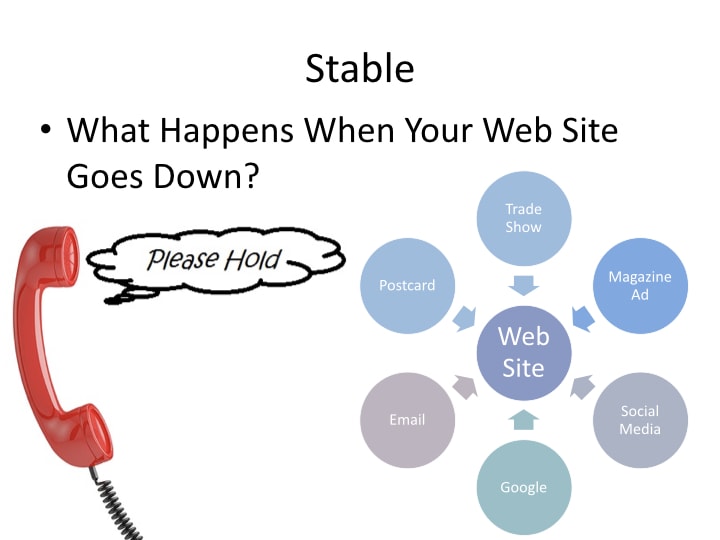 Paula Williams: Whether it’s two o’clock in the afternoon or three o’clock in the morning or you know, whatever time of the day it is and you have to stop everything in your business, get on the phone with these people and talk to somebody that may or may not be able to help you. Right? And that you may or may not understand.
Paula Williams: Whether it’s two o’clock in the afternoon or three o’clock in the morning or you know, whatever time of the day it is and you have to stop everything in your business, get on the phone with these people and talk to somebody that may or may not be able to help you. Right? And that you may or may not understand.
Paula Williams: And to be honest, you shouldn’t even notice when your website goes out. You know, your website hosting companies should be on top of that and receive an alert and tell you what happened after the fact.
John Williams: Yeah, after the fact, because they should have already resolved and gotten back up and running.
Human beings, 24 x 7, who know about an outage before you see it.
Paula Williams: Exactly. So that’s the ideal and that’s really what we strive for. And the way that we do that is to actually have a human being. And in some cases that is actually yours truly who is on call, you know, to listen for those alerts.
Paula Williams: We don’t get very many of them because the platforms that we’re using are, are really stable.
John Williams: Mm-hmm (affirmative).
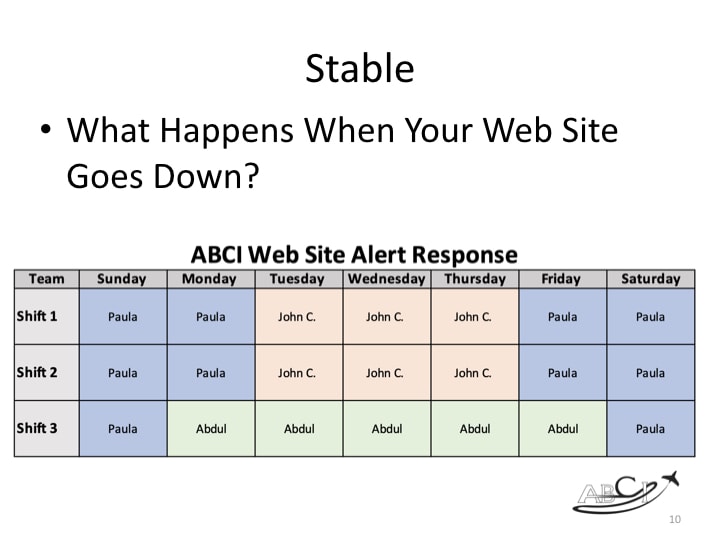 Paula Williams: That’s out of self defense. It’s maybe once every couple of weeks that we get a notification that there’s a blip on a website, either a slow or a not loading website for more than a minute, we get an automated notification and whoever’s on call jumps on it and takes care of it, right?
Paula Williams: That’s out of self defense. It’s maybe once every couple of weeks that we get a notification that there’s a blip on a website, either a slow or a not loading website for more than a minute, we get an automated notification and whoever’s on call jumps on it and takes care of it, right?
John Williams: Yep.
Paula Williams: Okay. So you know, we’re the ones who are worrying about that and sweating about it. And then we send you a notice and say, you know, your website was down for about 15 minutes this afternoon or at three o’clock in the morning and you know, here’s why and here’s what we did about it and here’s how we’re going to prevent that from happening again.
John Williams: Right.
Paula Williams: So, you know, depending on how complex your website is and how many systems it’s connected to, something needs to be done to fix that. And in some cases it’s not your web host problem.
Paula Williams: And so you’re going to end up with a lot of finger pointing back and forth and side to side.
John Williams: Yes.
Paula Williams: So having a human being who’s in charge of that process is really important with us.
John Williams: Yep, with us you have one throat to choke.
Paula Williams: That’s nice. Exactly. But you have one person who is on the hook and who takes your and who knows how important your marketing is to your business cause we’re sitting here lecturing about it. Right?
John Williams: Exactly.
Web site service provider checklist
Paula Williams: Okay, all right. So there is a checklist that we put together things to look for in a website service provider and you can get that from our website.
Paula Williams: Our website is up and running when you’re watching this podcast., Right?
John Williams: It dang well better be.
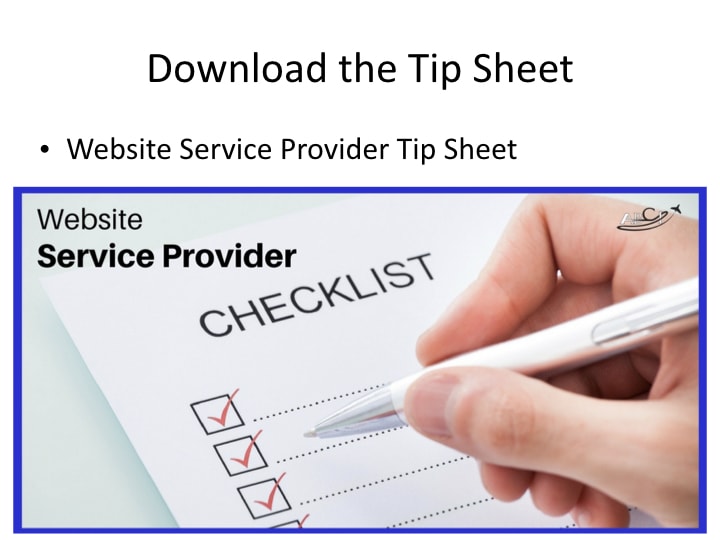 Paula Williams: So if you just search for website service provider checklist or go to tip sheets at the top of our website and you’ll see all of the tips sheets that we have, this website service provider checklist.
Paula Williams: So if you just search for website service provider checklist or go to tip sheets at the top of our website and you’ll see all of the tips sheets that we have, this website service provider checklist.
Paula Williams: If you’re shopping. And granted we are not the least expensive option on the market.
John Williams: No.
Paula Williams: And some people who can’t afford us, yet have to do something other than us and we totally get that. But you do want to make sure that you use that checklist and get the best option for you.
John Williams: Yeah, because in fact, we’ve changed hosting services a few times over time and now we have one who got us, over 90 days. We’re at a hundred percent uptime thing, and our load time is reduced from little over four seconds down to one give or take.
Paula Williams: Right. So you’re looking for speed, you’re looking for stability above all and you know all of those things are important. But if it’s not stable then almost everything else you do becomes less effective. And anything else that you invest in or work so hard for is going to be a lot less effective.
John Williams: Yep.
An ideal time for a Web Site Refresh?
Paula Williams: Okay. So this website, this website? This episode … this episode has been brought to you by our ABCI Web Site refresh. And once again, you can get three free videos in order your Web Site Refresh before March 31st of 2020.
Paula Williams: And we know it sometimes takes a little while to decide do we want to refresh our website this year? If we’ve been thinking about it for a while, now’s a really good time so that you can get that extra bonus. Right?
Go sell more stuff!
 Paula Williams: All right, so go sell more stuff!
Paula Williams: All right, so go sell more stuff!
John Williams: American needs business, and that’s a Zig Ziglar quote and he’s exactly correct and it’s still functional.
Paula Williams: Absolutely. Some things never change, right?
John Williams: Yep.
Paula Williams: Okay. Thanks for joining us. We’ll see you next week.
John Williams: See you next week.
More Aviation Web Site Resources
Want to evaluate your own website and/or service provider?
Download our Website Service Provider Checklist
Aviation Website Refresh Service
Other articles about Aviation Web Design:
ABCI Responsive Web Design Process
Aviation Website Not Attracting Customers
How to Get Attention on the Web
Best Aviation Websites for Marketing
Aviation Website Design – What Works?
Three Aviation Website Design Mistakes that Cost You Sales
Podcast: Play in new window | Download
Subscribe: Google Podcasts | Spotify | Amazon Music | RSS


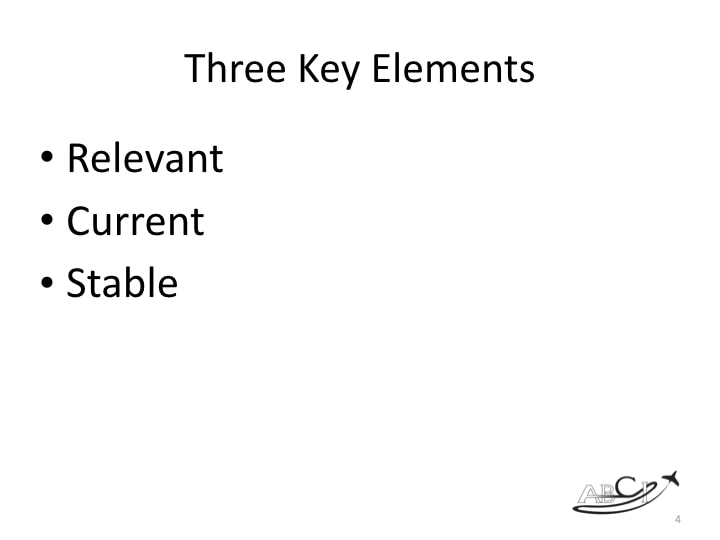
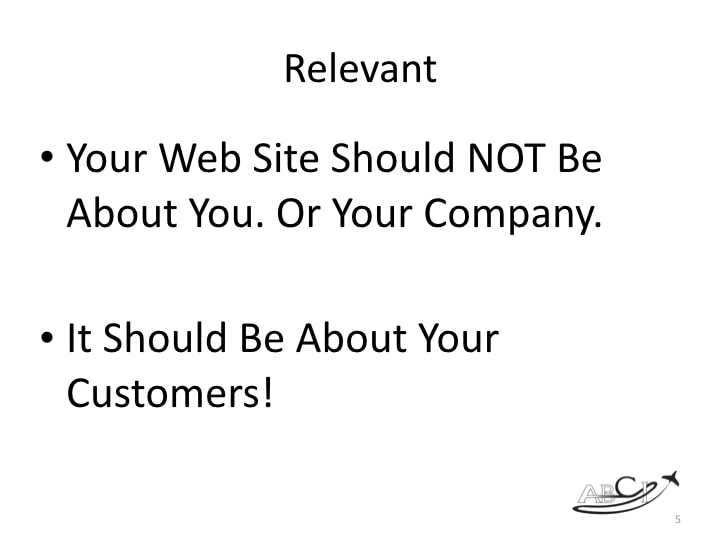
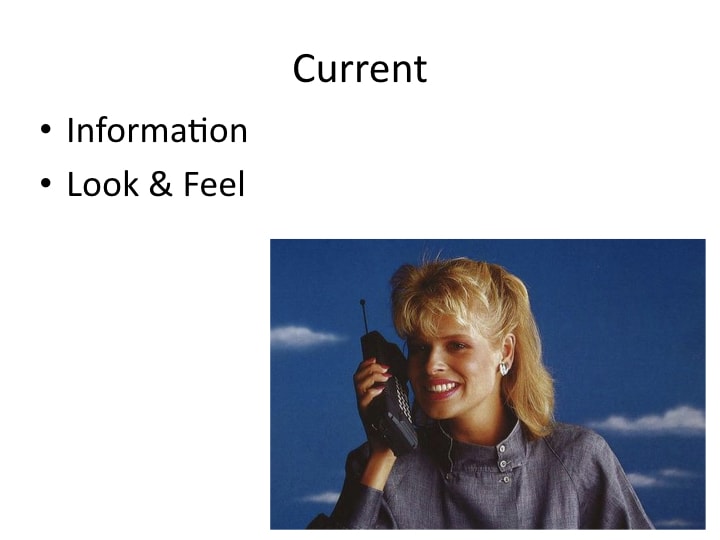
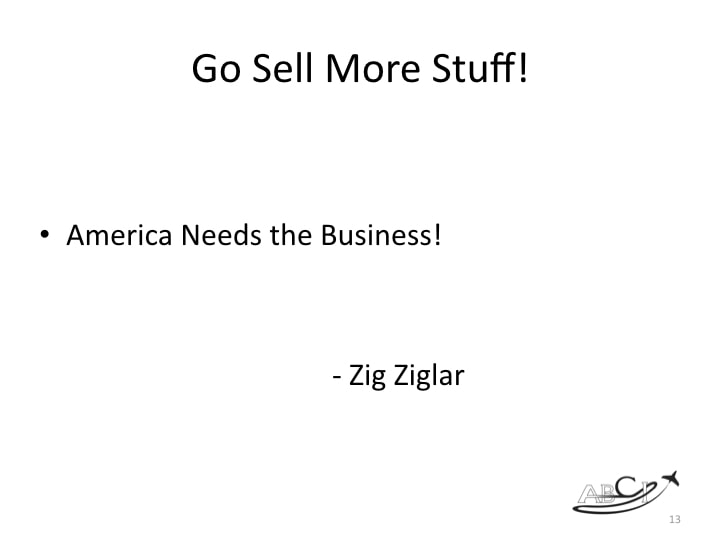





Helpful blog lots of information about it, Thank you admin for providing this information.